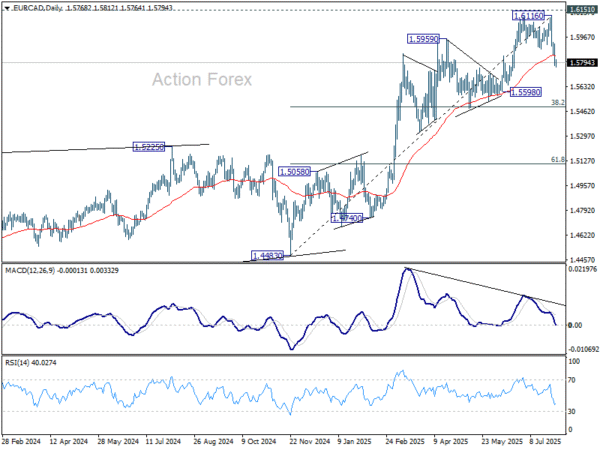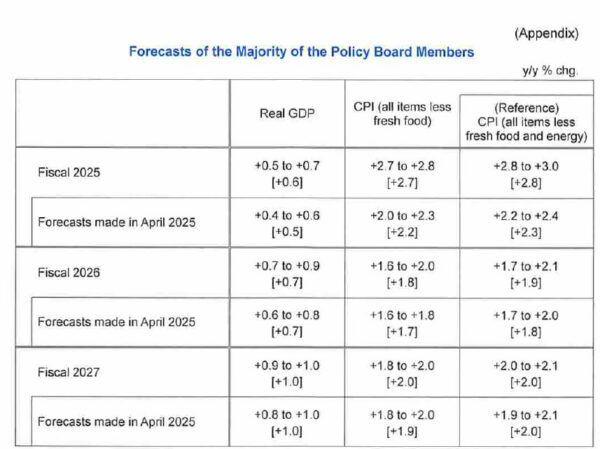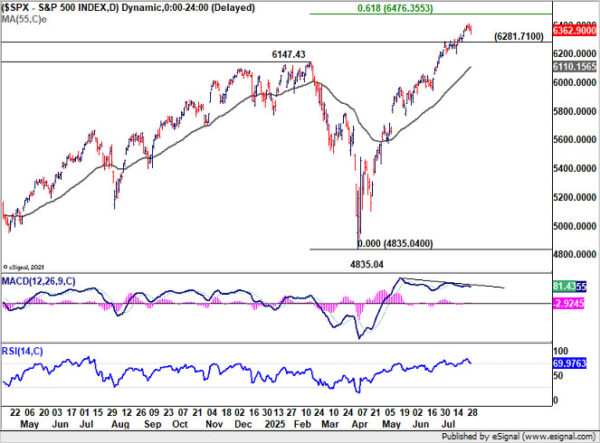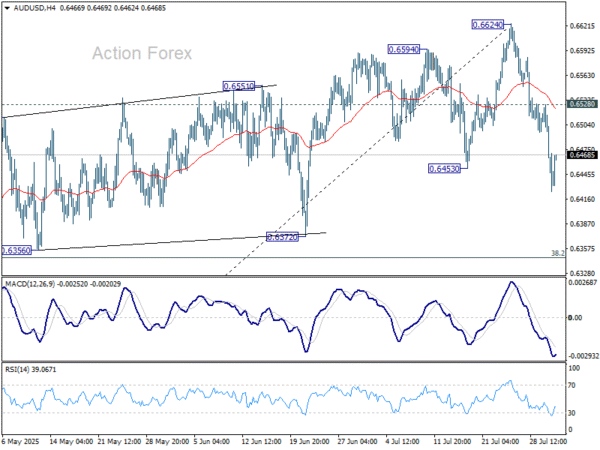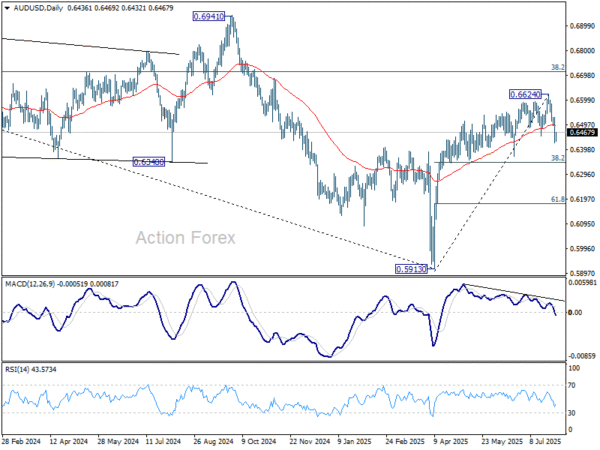Dollar Dominance Continues Amid Fed Repricing; Trump Secures Korea Deal, Targets India – Action Forex
Dollar remains the clear outperformer this week, holding firm despite mild retreat in Asian session. Stronger-than-expected US Q2 GDP data have prompted a significant paring back of expectations for a September Fed rate cut. Adding to the hawkish tilt, Fed Chair Jerome Powell struck a more guarded tone at the post-meeting press conference. Markets are now keenly focused on today’s PCE inflation and Friday’s non-farm payrolls for further clues.
Across the broader currency market, Yen ranks second strongest behind Dollar. BoJ’s upgraded inflation forecasts signal greater comfort that inflation will eventually trend sustainably around target, thus supporting further tightening ahead. Loonie is also gained ground, as the BoC struck a balanced tone by keeping the door open for further easing but offering no clear timeline. ON the other hand, Euro, Aussie, and Kiwi lag behind. Sterling and Swiss Franc sit in a neutral zone.
On the trade front, US President Donald Trump declared a “Full and Complete” trade agreement with South Korea. The deal caps blanket tariffs on Korean exports at 15%, down from the 25% initially threatened. Auto tariffs were also reduced from 25% to 15%. The timing of the agreement is critical, coming just ahead of the August 1 implementation window for new tariffs.
The pact also includes a USD350 billion South Korean investment package into the U.S., which Trump said will be “owned and controlled” by the US government and guided by presidential authority. Commerce Secretary Howard Lutnick elaborated that 90% of the profits from those funds would flow directly to American interests. The structure mirrors elements of the US–Japan agreement signed earlier this month.
However, South Korean President Lee Jae-myung offered a different framing, stressing that the investment aims to support Korean companies in entering high-tech US industries such as shipbuilding, semiconductors, and biotech. Of the total, USD 150 billion will target shipbuilding collaboration, aimed at cementing a competitive foothold in the US industrial base. Lee emphasized that mutual benefit—not unilateral concessions—must be the goal of any agreement with Washington.
While Seoul secured a deal, India is under renewed pressure. Trump announced a 25% tariff on Indian imports effective Friday, citing excessive trade barriers and India’s participation in BRICS. The president accused India of undermining US interests with non-monetary trade barriers and continued purchases of Russian oil and arms. However, he hinted that negotiations are ongoing and a resolution could still be reached by the end of the week. The move highlights Trump’s broader effort to isolate BRICS-aligned economies and reward cooperative partners with reduced trade penalties.
Technically, EUR/CAD’s steep decline this week confirm short term toping at 1.6116, just ahead of 1.6151 key resistance (2018 high). Fall from there is seen as correcting the five-wave rally from 1.4483. Deeper decline would be seen to 1.5598 support or even further to 38.2% retracement of 1.4483 to 1.6116 at 1.5492.
In Asia, at the time of writing, Nikkei is up 1.10%. Hong Kong HSI is down -1.26%. China Shanghai SSE is down -0.80%. Singapore Strait Times is down -0.73%. Japan 10-year JGB yield is down -0.001 at 1.562. Overnight, DOW fell -0.38%. S&P 500 fell -0.12%. NASDAQ rose 0.15%. 10-year yield rose 0.046 to 4.376.
BoJ holds at 0.50%, lifts 2025 inflation projections sharply on food costs
The BoJ kept its short-term policy rate unchanged at 0.50% as expected, reaffirming its cautious stance in the face of growing external risks. While the central bank reiterated its intention to continue normalizing policy in light of improving economic and price conditions, it also cited heightened uncertainty around global trade and policy developments as justification for a steady hand.
In its latest quarterly outlook, the BoJ sharply raised its inflation forecasts. Core CPI for fiscal 2025 was lifted from 2.2% to 2.7%. Core-core CPI, which excludes both fresh food and energy, jumped from 2.3% to 2.8%. The upward revisions were largely attributed to food price increases, though the BoJ still sees underlying inflation remaining subdued in the first half of the forecast horizon.
For fiscal 2026, core CPI was revised slightly higher from 1.7% to 1.8%, and core-core CPI from 1.8% to 1.9%. Projections for fiscal 2027 remained unchanged at 2.0% for both measures. The Bank noted that inflation will pick up toward levels “generally consistent” with the price stability target in the second half of the projection period.
Growth outlooks were little changed. The fiscal 2025 GDP forecast was lifted modestly to 0.6% from 0.5%, while estimates for fiscal 2026 and 2027 were held at 0.7% and 1.0%, respectively. The Bank continues to expect a slow but steady recovery, supported by resilient domestic demand and improvements in global conditions.
BoJ emphasized that the risk balance for growth remains tilted to the downside for 2025 and 2026, though price risks are now broadly balanced.
Fed Powell’s caution cools September cut bets, stocks end mixed
U.S. stocks ended mixed overnight after the Fed held its policy rate steady at 4.25–4.50%, in line with market expectations. The dissenting votes from Governors Christopher Waller and Michelle Bowman in favor of a cut came as little surprise, reflecting known dovish leanings. However, Chair Jerome Powell’s tone in the press conference struck a more cautious chord than markets had anticipated.
Powell pushed back against speculation of a near-term pivot, stating firmly, “We have made no decisions about September.” That effectively left the door open, but offered little for those hoping for imminent easing. Powell also warned that while tariff-driven inflation may be transitory, “more persistent” effects couldn’t be ruled out.
Between now and the next FOMC meeting, two additional rounds of jobs and inflation reports will be released—giving the Fed a wider lens to assess policy needs.
Traders responded by paring back bets for a September cut. Market pricing now sees just a 43% chance of easing at the next meeting, down from 65% a day earlier. The message: the Fed may be approaching the end of its pause, but it’s not ready to blink just yet.
Technically, while S&P 500’s up trend continued this week, it’s clearly continuing to lose upward momentum as seen in bearish divergence condition in D MACD. 6500 psychological level is likely to cap upside and bring consolidations. That’s slightly above a major fibonacci level of 61.8% projection of 3491.58 to 6147.43 from 4835.04 at 6476.35. Break of 6281.71 support will indicate that a near term correction has already started towards 55 D EMA (now at 6110.15).
Asia data wrap: Japan and Australia outperform but China falters
Asian economies delivered mixed signals as fresh data highlighted strength in Japan and Australia while exposing continued softness in China.
Japan’s industrial production rose 1.7% mom in June, defying forecasts for a -0.7% mom decline. The surge was driven by a 14.8% mom jump in transport equipment excluding autos and strength in electronics, a positive surprise despite ongoing US tariffs. Retail sales also rose 2.0% yoy, slightly beating forecasts of 1.8% yoy.
Australian retail sales posted an impressive 1.2% monthly gain in June, sharply above the 0.4% mom consensus. The ABS attributed the spike to widespread discounting and new product launches.
Meanwhile, China’s July PMIs disappointed. The NBS Manufacturing PMI dipped from 49.7 to 49.3, remaining in contraction for the fourth straight month. The export component showed no signs of recovery, marking 15 months of sub-50 readings at 47.1 Non-Manufacturing PMI also weakened from 50.5 to 50.1, its lowest since November.
AUD/USD Daily Report
Daily Pivots: (S1) 0.6397; (P) 0.6463; (R1) 0.6500; More...
AUD/USD’s break of 0.6453 support confirms short term topping at 0.6624, on bearish divergence condition in D MACD. Fall from there is tentatively seen as a correction to rise from 0.5913. Intraday bias is now on the downside for 38.2% retracement of 0.5913 to 0.6624 at 0.6352. Strong support is expected from 0.6352 to bring rebound. Above 0.6528 minor resistance will turn intraday bias neutral first.
In the bigger picture, there is no clear sign that down trend from 0.8006 (2021 high) has completed. Rebound from 0.5913 is seen as a corrective move. While stronger rally cannot be ruled out, outlook will remain bearish as long as 38.2% retracement of 0.8006 to 0.5913 at 0.6713 holds. Nevertheless, considering bullish convergence condition in W MACD, even in case of another fall through 0.5913, downside should be contained above 0.5506 (2020 low).

